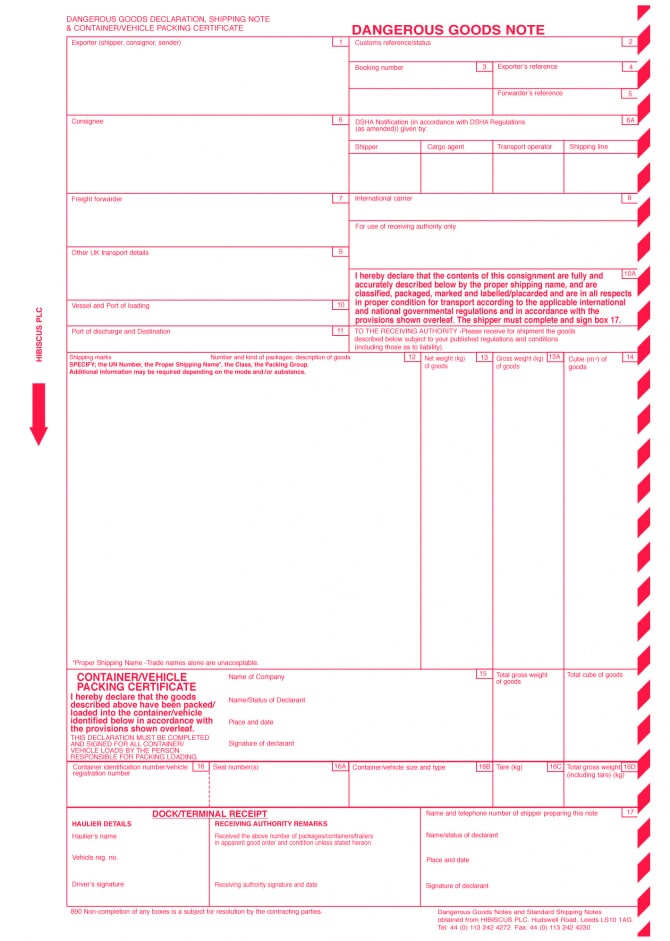ADR transport on the ferry: Step-by-step completion of the DGN declaration
The transport of dangerous goods is a special type of transport that requires not only appropriate conditions for particular goods, but also expert knowledge of legal regulations.

Transport of such substances also relates to the need to complete the Dangerous Goods Declaration, which gives many carriers sleepless nights.
Today we will show you how to complete this document in a few simple steps and what to enter in particular fields.
Is completion of DGN obligatory?
Completing the Dangerous Goods Declaration (pol. Deklaracja Ładunku Niebezpiecznego, DGN) is obligatory. Transport documents are usually completed in paper form. However, completing all the fields in the declaration is not required.
ADR transport on the ferry: What should be included in the Dangerous Goods Declaration?
Regardless of the transported dangerous goods, each declaration should include information which enables identification of:
- transportedmaterials (UN number, proper shipping name),
- hazards posed by transported materials (classification code/numbers of label templates/class/subclass/additional hazards),
- severity of the hazard (packing group, if any),
- The number and type of packages, correct packaging of goods (if applicable, the number and description of packages/packing instruction),
- restriction code for transport in tunnels
- quantity of each dangerous goods in transport
- total amount
- entities dispatching and receiving the dangerous goods. (the name and address of the recipient, as well as the name and address of the sender)
Dangerous Goods Declaration in sea transport
DATES AND SIGNATURES OF THE SHIPPER, as well as DATES AND SIGNATURES OF THE PERSON RESPONSIBLE FOR LOADING, in field 15, are very important for declarations completed for ferry transport purposes.
Template of Dangerous Goods Declaration
Dangerous Goods Declaration template to download.
ADR transport on the ferry: What should be entered in the individual fields of the DGN declaration?
Below we present what should be entered in the individual fields of the Dangerous Goods Declaration:
1.Exporter - exporter's name and address, including postal code and contact details (telephone, fax, e-mail).
2.Customs reference/status - enter the reference number of the exported consignment here (UCR - Unique Consignment Reference). Important! It should be compliant with the format established in HM Revenue & Customs.
WARNING! DO NOT enter in this field the number of the export contract (box 4) or details concerning specification of the goods (box 12)
3.Booking number - reference number of the order or consignment (from ferry operator or combined transport operator).
4.Exporter's reference - symbol and number of the export contract or order. It is not compulsory if it is provided in subitem 2.
5.Forwarder's reference - symbol and number of the forwarding order, to which the Dangerous Goods Declaration refers.
6.Consignee - enter the name and full address of the buyer, including contact details (telephone, fax, e-mail number) here.
6A - DSHA Notification - notification of the DSHA concerning bringing in dangerous substances to the port area - mark with a cross (X) next to the person who makes the verification - carrier, cargo agent, transport operator, ferry operator).
7.Freight forwarder - the name and full address of the freight forwarder who arranges the shipment of dangerous goods, including contact details.
8.International carrier - the name and full address of the international carrier involved in transport of dangerous goods, including contact details (telephone, fax, e-mail number). This field needs to be completed only in the event the cargo is transported by sea, inland waterway, rail or road. In the case of air or intermodal transport, this field should be left blank.
9.Other UK transport details - other details regarding transport of dangerous goods, e.g. the name of the storage facility, storage location of the goods in the port, the dates on which the goods are ready for shipment, delivery date of the goods to the port, requirements of a particular carrier, delivery address, etc.
10.Vessel and port of loading - the name of the ship intended for dangerous goods transport and the name of the seaport (in its original version) where the loading takes place.
10A - the statement of accuracy of information provided in this declaration.
11.Port of discharge and destination - the place of unloading the dangerous goods from the ship (name of the seaport in its original version).
12.Consignment information - detailed shipping information: a). the UN number - UN number, b). the Proper Shipping Name - enter the trade name together with the technical name here. If the trade name of the goods is not compliant with the name listed in the UN Dangerous Goods nomenclature, then both names should be provided when filling in this field, c). The Class - hazard class based on the nomenclature of the International Maritime Organization (IMO), d). The Packing Group - packing group, e). The Sequence of the Information - the above information should be entered in the following order: a b c d, f). The Number and Kind of Package - number of packages and types of packages, g). Additional Information - additional information - chemical specification:
- special requirements for individual classes, such as: radioactive or infectious substance; - recyclable packaging, waste, transport in increased temperature; - empty and uncleaned packages or container; - quantitative restrictions for transport; polluting substances; flash point.
In addition, enter the number of transported goods according to the UN dangerous goods nomenclature, as well as the appropriate code of goods according to the type of transport: “International Maritime Dangerous Goods Code" ( sea transport),"Annex 1 to the Uniform Rules concerning the Contract for International Carriage of Goods by Rail – RID” (rail transport) or ”European Agreement concerning the International Carriage of Dangerous Goods by Road – ADR” (road transport).
h). Customs - information for customs clearance. When the transported goods constitute a part of collective shipment, the Master UCR (MUCR) should be provided - the same format as in item 2.
13.Net weight (kg) of goods - net weight of the dangerous cargo, expressed in kilograms.
13A.
i. Gross weight of goods - gross weight of each dangerous cargo. ii. Total gross weight of goods - total gross weight of all dangerous goods transported. For cargo in containers, total container weight should be provided.
14.Cubic volume (m3) of goods - volume in cubic meters of each dangerous cargo.
Total cubic volume of goods - total volume of dangerous goods.
15.Container/vehicle packing certificate and declaration (CVPC) – With the container/vehicle packing certificate, you should enter here: company name; name and surname of the declarant; place and date of issue for the declaration as well as the declarant's signature.
16.Container identification number/vehicle registration number - you should provide the container identification number or vehicle registration number here
16A.Seal numbers - the numbers and marks of seals placed on the container or on the vehicle door or on the wagon door.
16B.Container/vehicle size & type - the size and type of the container or vehicle.
16C Tare (kg) - container weight (kg).
16D Total gross weight (including tare) - total gross weight of the dangerous goods, obtained by adding up the gross weight (entered in field 13a) and the container tare (entered in field 16c).
Fields 16-16D are to be completed by the carrier.
17. To be filled in in this order:
- name of the company issuing the Dangerous Goods Declaration (manufacturer) including its contact details; - name and position of the person who draws up the declaration and is responsible for accuracy of information provided therein; - the issue place and date of declaration, including the signature.
Prepared by:
A.Wojcinska


